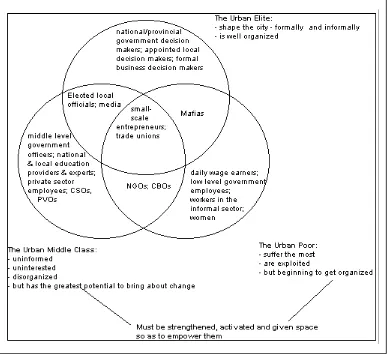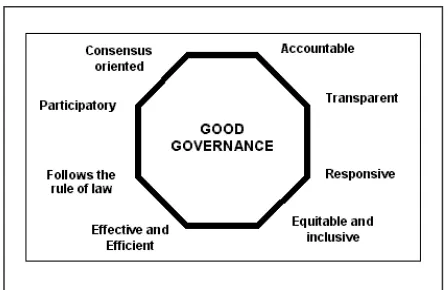United Nations
Economic and Social Commission for Asia and the
Pacific
W h a t i s G o o d G o v e r n a n c e ?
I
I
n
n
t
t
r
ro
o
d
d
u
u
c
c
t
t
i
i
o
o
n
n
Recently the terms "governance" and "good governance" are being increasingly used in development literature. Bad governance is being increasingly regarded as one of the root causes of all evil within our societies. Major donors and international financial institutions are increasingly basing their aid and loans on the condition that reforms that ensure "good governance" are undertaken. This article tries to explain, as simply as possible, what "governance" and "good governance" means.
G
G
o
o
v
v
e
e
rn
r
n
a
a
n
n
c
c
e
e
The concept of "governance" is not new. It is as old as human civilization. Simply put "governance" means: the process of decision-making and the process by which decisions are implemented (or not implemented). Governance can be used in several contexts such as corporate governance, international governance, national governance and local governance. Since governance is the process of decision-making and the process by which decisions are implemented, an analysis of governance focuses on the formal and informal actors involved in decision-making and implementing the decisions made and the formal and informal structures that have been set in place to arrive at and implement the decision.
Government is one of the actors in governance. Other actors involved in governance vary depending on the level of government that is under discussion. In rural areas, for example, other actors may include influential land lords, associations of peasant farmers, cooperatives, NGOs, research
institutes, religious leaders, finance institutions political parties, the military etc. The situation in urban areas is much more complex. Figure 1 provides the interconnections between actors involved in urban governance. At the national level, in addition to the above actors, media, lobbyists, international donors, multi-national corporations, etc. may play a role in decision-making or in influencing the decision-decision-making process.
All actors other than government and the military are grouped together as part of the "civil society." In some countries in addition to the civil society, organized crime syndicates also influence decision-making, particularly in urban areas and at the national level.
Similarly formal government structures are one means by which decisions are arrived at and implemented. At the national level, informal decision-making structures, such as "kitchen cabinets" or informal advisors may exist. In urban areas, organized crime syndicates such as the "land Mafia" may influence decision-making. In some rural areas locally powerful families may make or influence decision-making. Such, informal decision-making is often the result of corrupt practices or leads to corrupt practices.
G
G
o
o
o
o
d
d
G
G
o
o
v
v
e
e
rn
r
na
a
n
nc
c
e
e
Figure 1: Urban actors
Pa rt ic ipa t ion
Participation by both men and women is a key cornerstone of good governance. Participation could be either direct or through legitimate intermediate institutions or representatives. It is important to point out that representative democracy does not necessarily mean that the concerns of the most vulnerable in society would be taken into consideration in decision making. Participation needs to be informed and organized. This means freedom of association and expression on the one hand and an organized civil society on the other hand.
Rule of la w
Good governance requires fair legal frameworks that are enforced impartially. It also requires full protection of human rights, particularly those of minorities. Impartial enforcement of laws requires an independent
judiciary and an impartial and incorruptible police force.
T ra nspa re nc y
Transparency means that decisions taken and their enforcement are done in a manner that follows rules and regulations. It also means that information is freely available and directly accessible to those who will be affected by such decisions and their enforcement. It also means that enough information is provided and that it is provided in easily understandable forms and media.
Re sponsive ne ss
Figure 2: Characteristics of good governance
Conse nsus orie nt e d
There are several actors and as many view points in a given society. Good governance requires mediation of the different interests in society to reach a broad consensus in society on what is in the best interest of the whole community and how this can be achieved. It also requires a broad and long-term perspective on what is needed for sustainable human development and how to achieve the goals of such development. This can only result from an understanding of the historical, cultural and social contexts of a given society or community.
Equit y a nd inc lusive ne ss
A society’s well being depends on ensuring that all its members feel that they have a stake in it and do not feel excluded from the mainstream of society. This requires all groups, but particularly the most vulnerable, have opportunities to improve or maintain their well being.
Effe c t ive ne ss a nd e ffic ie nc y
Good governance means that processes and institutions produce results that meet the needs of society while making the best use of resources at their disposal. The concept of efficiency in the context of good governance also covers the sustainable use of natural resources and the protection of the environment.
Ac c ount a bilit y
Accountability is a key requirement of good governance. Not only governmental institutions but also the private sector and civil society organizations must be accountable to the public and to their
institutional stakeholders. Who is accountable to whom varies depending on whether decisions or actions taken are internal or external to an organization or institution. In general an organization or an institution is accountable to those who will be affected by its decisions or actions. Accountability cannot be enforced without transparency and the rule of law.
C
C
o
o
n
n
c
c
l
l
u
u
s
s
i
i
o
o
n
n
From the above discussion it should be clear that good governance is an ideal which is difficult to achieve in its totality. Very few countries and societies have come close to achieving good governance in its totality. However, to ensure sustainable human development, actions must be taken to work towards this ideal with the aim of making it a reality.
M
M
o
o
re
r
e
i
i
n
n
fo
f
o
r
r
m
m
a
a
t
t
i
i
o
on
n
Mr. Yap Kioe Sheng Chief,
Poverty Reduction Section UNESCAP, UN Building, Rajdamnern Nok Ave. Bangkok 10200, Thailand Tel: 66-2-288-1600 Fax: 66-2-288 1056

